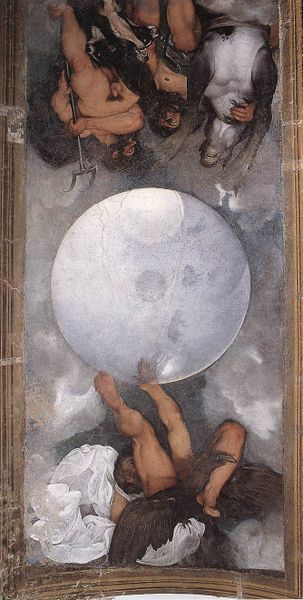Jupiter, Neptune and Pluto
- Jupiter, Neptune and Pluto
Infobox Painting|

title=Jupiter, Neptune and Pluto
artist=Caravaggio
year=c. 1597
type=Oil on plaster ceiling
height=300
width=180
city=Rome
museum=Villa Ludovisi
"Jupiter, Neptune and Pluto" (c. 1597) is a painting by the Italian Baroque master Michelangelo Merisi da Caravaggio, located in the casino of the Villa Ludovisi, Rome. It is unusual in being painted in oils on plaster - oil painting is normally on canvas or, less frequently, on wood.
According to an early biographer, one of Caravaggio's aims was to show up critics who claimed that he had no grasp of perspective - these three figures demonstrate the most dramatic foreshortening imaginable. They also should give pause to those who claim that he always painted from live models.
The painting was done for Caravaggio's patron Cardinal Francesco Maria Del Monte, on the ceiling of the cardinal's garden villa at porta Pinciana. Here the cardinal dabbled in alchemy, and Caravaggio has painted an allegory of the alchemical triad of Paracelsus - Jupiter stands for sulphur and air, Neptune for mercury and water, and Pluto for salt and earth. Each is identified by his beast, Jupiter by the eagle, Neptune the seahorse, Pluto by the three-headed dog cerberus. Jupiter is reaching out to move the celestial sphere in which the sun revolves around the Earth - Galileo was a friend of Del Monte but had yet to make his mark on cosmology.
Wikimedia Foundation.
2010.
Look at other dictionaries:
Pluto — This article is about the dwarf planet. For other uses, see Pluto (disambiguation). Pluto … Wikipedia
neptune — /nep toohn, tyoohn/, n. any whelk of the genus Neptunea, esp. N. decemcostata, common along the eastern coast of North America and having a shell with seven to ten raised reddish brown spiral ridges on a pale beige or yellow background. [ < NL… … Universalium
Neptune — /nep toohn, tyoohn/, n. 1. the ancient Roman god of the sea, identified with the Greek god Poseidon. 2. the sea or ocean: Neptune s mighty roar. 3. Astron. the planet eighth in order from the sun, having an equatorial diameter of 30,200 mi.… … Universalium
Pluto — /plooh toh/, n. 1. Class. Myth. a name given to Hades, under which he is identified by the Romans with Orcus. 2. Astron. the planet ninth in order from the sun, having an equatorial diameter of about 2100 miles (3300 km), a mean distance from the … Universalium
Neptune (mythology) — Neptune velificans in his triumphal chariot drawn by hippocamps (mid 3rd century AD, Musée archéologique de Sousse) Ancient Roman religion … Wikipedia
Pluto (mythology) — Pluto was the Roman god of the underworld, known in Latin as Tertius, the counterpart of the Greek Hades.OverviewPluto was originally the Roman god of certain metals and, because these materials are mined, he also took on the role of god of the… … Wikipedia
Nativity with St. Francis and St. Lawrence — Artist Caravaggio Year 1609 Type Oil on canvas Dimensions 268 cm × 197 cm (106 in × 78 in) … Wikipedia
Martha and Mary Magdalene (Caravaggio) — Martha and Mary Magdalene Artist Caravaggio Year c. 1598 Type Oil on canvas Dimensions 100 cm × 134.5 cm (39 in × 53.0 in) Location … Wikipedia
David and Goliath (Caravaggio) — David and Goliath (or David with the Head of Goliath or David Victorious over Goliath) is a painting by the Italian Baroque master Caravaggio (1571 1610). It was painted in about 1599, and is held in the Museo del Prado, Madrid. Two later… … Wikipedia
Neptune — This article is about the planet. For other uses, see Neptune (disambiguation). Neptune … Wikipedia

